Tale of the Tape: OnePlus One Compared to Top Smartphones
We pull out our slide rules and spec sheets to measure up the OnePlus One with other leading smartphones.
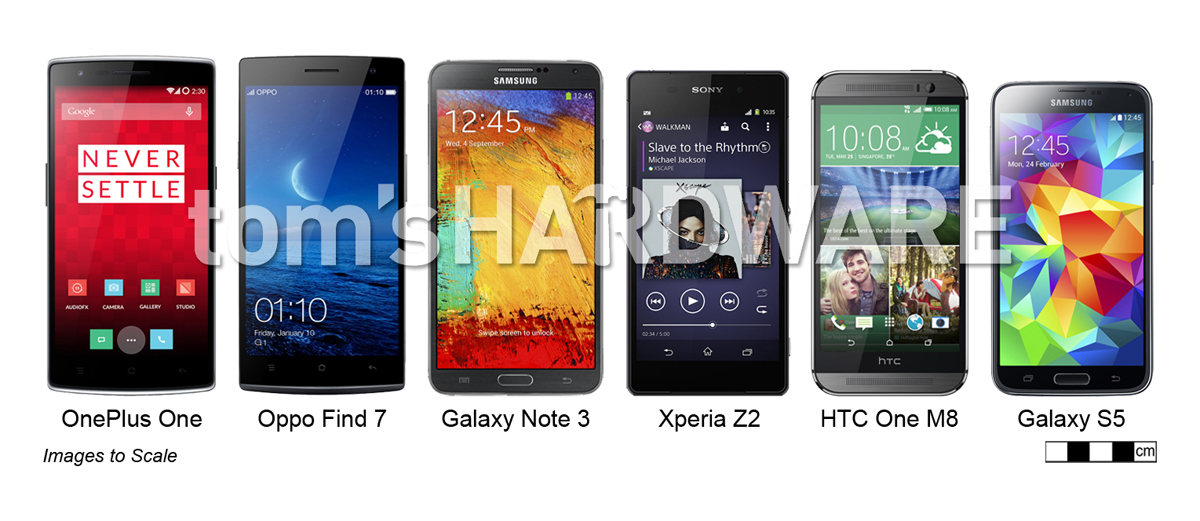
OnePlus has certainly impressed us with the One. When the full details were finally announced on April 23, it seemed unbelievable that a phone with such high-end specs would start at $300. Soon after OnePlus's site crashed from all the traffic, social media was full of buzz for what it is calling the "2014 flagship killer." Now that we've had time to reflect, let's look a little more closely at the One, and see if it, at least on paper, lives up to that claim.
We'll be comparing the One to five other leading smartphones: the Oppo Find 7a, the Samsung Galaxy Note 3, the Sony Xperia Z2, the HTC One M8 and the Samsung Galaxy S5. While this comparison is solely based on paper specs, hopefully, we'll be able to get our hands on a One soon, so we can give you some hands-on impressions and compare it to some of these phones in person.
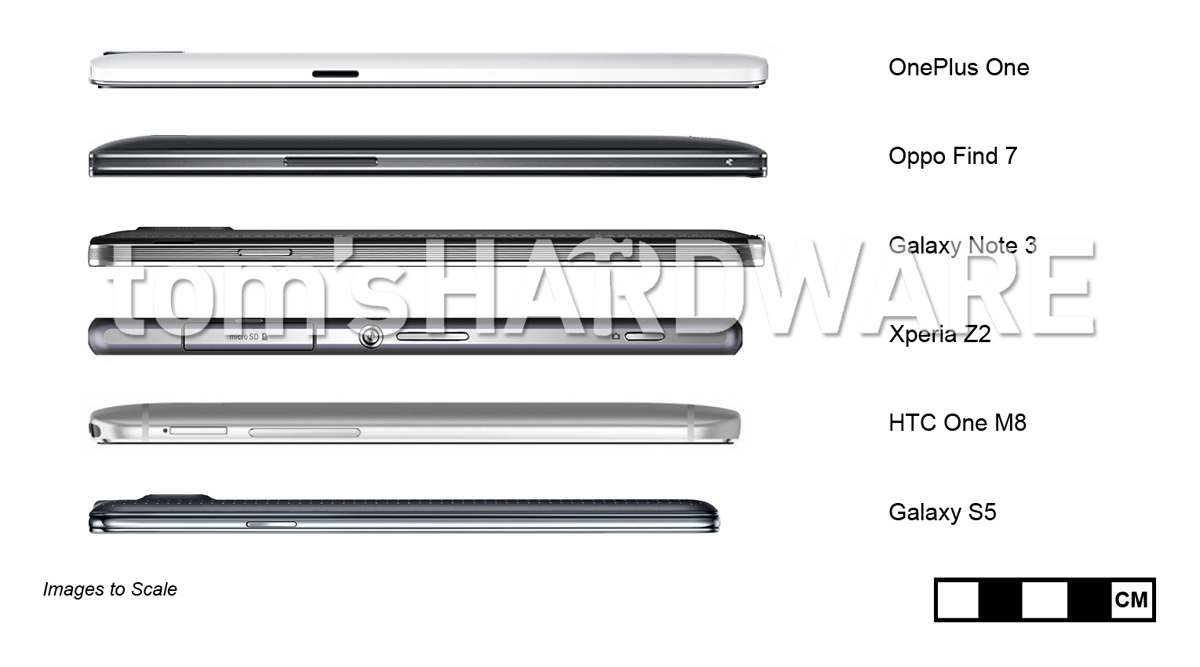
Dimensions
| Header Cell - Column 0 | OnePlus One | Oppo Find 7a | Samsung Galaxy Note 3 | Sony Xperia Z2 | HTC One M8 | Samsung Galaxy S5 |
|---|---|---|---|---|---|---|
| Screen Size | 5.5-inch | 5.5-inch | 5.7-inch | 5.2-inch | 5.0-inch | 5.1-inch |
| Height mm/inch | 152.9 mm6.02" | 152.6 mm6.01" | 151.2 mm5.95" | 146.8 mm5.78" | 146.36 mm5.76" | 142 mm5.59" |
| Width mm/inch | 75.9 mm2.99" | 75 mm2.95" | 79.2 mm3.12" | 73.3 mm2.88" | 70.6 mm2.78" | 72.5 mm2.85" |
| Depth mm/inch | 8.9 mm0.35" | 9.2 mm0.36" | 8.3 mm0.33" | 8.2 mm0.32" | 9.35 mm0.37" | 8.1 mm0.32" |
| Weightg/oz | 162 g5.71 oz | 170 g6 oz | 168 g5.93 oz | 163 g5.75 oz | 160 g5.64 oz | 145 g5.11 oz |
In early March, one of OnePlus's weekly mini-announcements pertained to One's size, with the bold claim that it had "fit a 5.5-inch" screen into a 5.0" handset." A picture supposedly showing the One underneath the Xperia Z1 was also posted on its forums as proof. Well, let's be honest. The final specs of the One clearly show that it isn't a 5-inch phone with a 5.5-inch screen. While we are not going to go as far as some of its fans have by saying that OnePlus was being dishonest with this claim, it's clear that perhaps the truth was bent a little here to suit the marketing department's needs.
While the One's size doesn't bother me personally, since I am a fan of big phones, I can see why some people are a little upset that it is a lot bigger than they were expecting. As you can see, it's the tallest of all the phones we are comparing it to, which is the most important dimension when thinking about one-handed usability. For most people, when holding the One in one hand, it is too tall to be able to comfortably reach the top of the screen to, say, pull down the notification tray. However, on the other hand, ALL of the phones in this comparison, apart from maybe the Galaxy S5, are realistically too tall for comfortable one-handed use, and if you compare the One to phablets like the LG G Pro 2 or HTC One Max, it's actually quite compact.
On the width front, while the One is a wide phone, it is not as wide as the Galaxy Note 3. The Note's extra width and narrow bezels allow it to impressively incorporate a larger 5.7-inch screen in a comparably sized package to both the One and Find 7a. As for the thickness of these phones, they are pretty much all the same, apart from the slightly slimmer Galaxy S5.
Weight is the one area in this dimensional comparison where the One excels. By using a magnesium chassis, OnePlus has been able to keep its weight down without sacrificing overall chassis stiffness and durability. Of course, the Galaxy S5 still trumps it, but that's due to its all plastic construction.
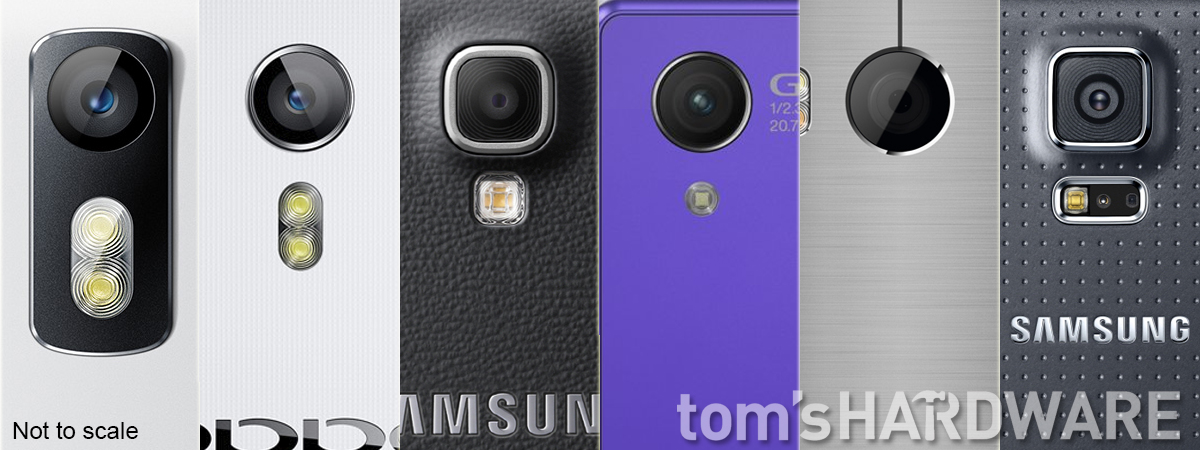
Camera Specifications
| Header Cell - Column 0 | OnePlus One | OppoFind 7a | Samsung GalaxyNote 3 | Sony Xperia Z2 | HTC OneM8 | Samsung Galaxy S5 |
|---|---|---|---|---|---|---|
| Rear Sensor MP | 13 MP | 13 MP | 13 MP | 20.7 MP | 4 MP | 16 MP |
| Rear Pixel/ Sensor Size & Model | 1.12 µm, 1/3.0"Sony IMX214 Exmor RS | 1.12 µm, 1/3.0"Sony IMX214 Exmor RS | 1.12 µm, 1/3.0"Sony IMX135Exmor RS | 1.18 μm, 1/2.3"SonyIMX??? Exmor RS | 2.02 μm, 1/3.0"HTC Ultrapixel | 1.12 µm, 1/2.6" Samsung ISOCELL |
| Rear Aperture | f/2.0 | f/2.0 | f/2.2 | f/2.0 | f/2.0 | f/2.2 |
| Rear Focal Length | 28 mm | 28 mm | 31 mm | 27 mm | 28 mm | 31 mm |
| Rear Lens | 6-element | 6-element 'Blue Glass' | N/A | G Lens | Secondary Depth Camera | N/A |
| OIS | NO | NO | NO | NO | NO | NO |
| Flash | Dual LED | Dual LED | Single LED | Single LED | Dual LED | SingleLED |
| 4K Video | YES | YES | YES | YES | NO | YES |
| Front Camera | 5.0 MP | 5.0 MP | 2.0 MP | 2.2 MP | 5.0 MP | 2.0 MP |
OnePlus is saying that the One's 13 MP camera will deliver "astounding results," and the sample images on its product page certainly do look very good. Its specifications list checks some of the important camera feature boxes, such as having a wide f/2.0 aperture, 6-element lens and dual-LED flash, but we do not think, at least from the raw specs, that this camera is going to be vastly superior to the other phones in this comparison.
Get Tom's Hardware's best news and in-depth reviews, straight to your inbox.
As can be seen, the One has very similar camera specs to the Find 7a because both phones are manufactured by Oppo and are cousins with almost identical specifications; therefore, we can expect the camera performance of both these phones to be similar. They should produce better images than the Note 3, which is the oldest phone in this comparison. It suffers from both its older camera hardware and the less powerful ISP (image sensor processor) of its Snapdragon 800 SoC.
However, when compared on paper, the Xperia Z2 looks like it has a much better camera than the One. Its unnamed Sony Exmor RS sensor is both physically bigger and has more megapixels than the 1/3" IMX214 Sony in the One. It has a pixel size second only to the giant 2.02 μm of the HTC One M8's Ultrapixel camera. The Z2's sensor, along with its f/2.0 aperture should deliver the best low-light performance of all the phones here, apart from perhaps the M8's. While I have not been able to test the One yet, I have been using the Z2 for a week now and am VERY impressed with its camera.
When you compare the One's camera specifications to the HTC One M8, it looks like it should outperform it in all areas except low-light, where the M8 has the edge over all the cameras in this comparison due to the larger pixel size of its Ultrapixel sensor. The Galaxy S5's camera edges the One's in resolution, but doesn't have as wide of a lens or aperture.
It is a little disappointing to see that none of the phones here have optical image stabilization (OIS). While all of them claim to be able to do some form of image stabilization with software, there is no comparison quality-wise to having proper hardware OIS. Given the One's size, it would have been nice if OnePlus could have added this feature to its camera.
Another important aspect to consider here is the software that captures and processes the images. At CyanogenMod's OnePlus One launch event last week, some details about the One's camera app came out. The 11S version of CyanogenMod specifically designed for the One will have a redesigned camera app. While we don't know details such as how many shooting modes it will have, and if you have full manual control during the shooting process, there is a little bit more information over on CyanogenMod's product page for the One. There it says that you can "snap photos, record video, and sweep panoramas with a single tap. Plan your perfect image with the quick-access control bar." Also, OnePlus is claiming that the One will have "[o]ver 120 algorithms optimize pictures and videos by making them cleaner and sharper," so it is possible that the One will produce better images simply by having better software than other phones with superior camera hardware.
It is important to remember, though, that the only way to really determine who has the best camera is to use the phones and compare the pictures shot with them. I've taken photos with the Note 3, Xperia Z2, One M8 and Galaxy S5, and so far the Z2 comes out on top, so we'll need to get our hands on a OnePlus One to be able to properly evaluate its camera.
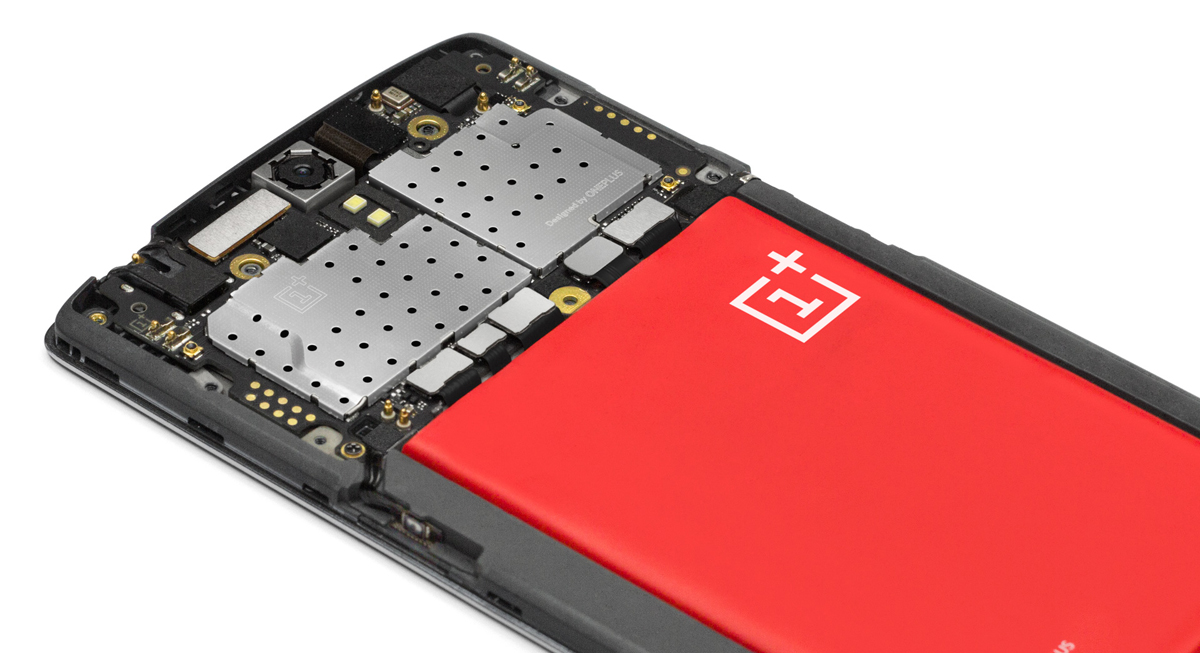
Additional Specifications
| Header Cell - Column 0 | OnePlus One | Oppo Find 7a | Samsung Galaxy Note 3 | Sony Xperia Z2 | HTC One M8 | Samsung Galaxy S5 |
|---|---|---|---|---|---|---|
| SoC | 2.45 GHz SD 801 (MSM8974AC) | 2.26 GHz SD 801 (MSM8974AB) | 2.26 GHz SD 800 (MSM8974AB) | 2.26 GHz SD 801 (MSM8974AB) | 2.26 GHz SD 801 (MSM8974AB) | 2.45 GHz SD 801 (MSM8974AC) |
| RAM | 3 GB | 2 GB | 3 GB | 3 GB | 2 GB | 2 GB |
| Storage | 16/64 GB | 16 GB | 32/64 GB | 16 GB | 16/32 GB | 16/32 GB |
| microSD slot | NO | YES | YES | YES | YES | YES |
| Screen Type | IPS LCD | IPS LCD | Super AMOLED | IPS LCD | Super LCD | SuperAMOLED |
| Resolution/ppi | 1080 x 1920/401 ppi | 1080 x 1920/401 ppi | 1080 x 1920/386 ppi | 1080 x 1920/424 ppi | 1080 x 1920/441 ppi | 1080 x 1920/432 ppi |
| Battery | 3,100mAh | 2,800 mAh | 3,200 mAh | 3,200 mAh | 2,600 mAh | 2,800mAh |
| USB 3.0 | NO | NO | YES | NO | NO | YES |
| Speakers | Stereo(bottom-facing) | Stereo(rear-facing) | Mono | Stereo (front-facing) | Stereo(front-facing) | Mono |
| LTE Int’l Bands | 1/3/4/7/17/38/40 | 1/3/7/20 | 1/3/5/7/8/20 | 1/2/3/4/5/7/8/13/17/20 | 3/7/8/20 | 1/2/3/5/7/8/20 |
| LTE NA Bands | N/A | 1/4/17 | 1/4/17 | N/A | 4/7/17 | 1/2/3/4/5/7/17 |
| OS | CyanogenMod 11S(Android 4.4) | ColorOS, (Android 4.3) | TouchWiz(Android 4.4) | Sony OS(Android 4.4) | Sense 6(Android 4.4) | TouchWiz(Android 4.4) |
As far as their SoCs go, all six of these phones are very similar (all but the Note 3). They use Qualcomm's latest silicon, the Snapdragon 801, and even then, the 800 in the Note is not noticeably that much slower in real-world conditions. Both the SD800 MSM8974AB and SD801 MSM8974AB chips have a CPU clock of 2.26 GHz. The SD800 AB has a GPU clock of 550 MHz and the SD801 AB runs at 578 MHz. The One, though, like the Galaxy S5, runs Qualcomm's top binned silicon, the MSM8974AC, which has a higher 2.45 GHz CPU clock, with all the other speeds being the same.
Being able to ship the One with Snapdragon 801 AC is a bit of a coup for OnePlus, since, at this time, it is one of only a handful of devices announced with this chip. If it got devices into people's hands soon, the One would be the second phone to ship with SD801 AC, after the Galaxy S5. However, again, like the difference between SD800 AB and SD801 AB, the real work performance benefit of an extra 0.19 GHz in CPU speed is going to be negligible. One big advantage Snapdragon 801 does have over last year's SD800 is the faster ISP that allows all the 2014 phones in this comparison to apply effects like HDR and background defocus on the fly when taking pictures.
The One has 3 GB of RAM, as do both the Note 3 and Xperia Z2. While in benchmarks this will help up the scores, in real world use there won't be a noticeable performance boost over the phones with 2 GB. It comes with either 16 GB or 64 GB of storage, but unfortunately, unlike its cousin the Find 7a, it does NOT have a microSD slot. While changes in the way Android 4.4 handles SD cards makes them less flexible than they were in previous versions of the OS, it is still disappointing that those who opt for the 16 GB One (which will be the first model to ship) will have no way to add additional capacity.
Looking at the screen technologies used by these phones, all but the Samsung’s are using LCD technology. All the screens have excellent viewing angles so the main difference between them would be that the phones with AMOLED screens will have deeper blacks and better contrast ratios, at the expense of less accurate colors. However, Samsung has addressed this issue with the panel in the S5, and our tests have shown that can be as accurate as LCD screens on other phones. Of course, you cannot properly evaluate the quality of a screen by looking at its paper specs, so we’ll just have to wait until we can get our hands on a One to see how good its screen is compared to the other phones here.
As far as pixels-per-inch goes, obviously the smaller the screen, the higher the ppi if they are all the same resolution, which all six of these phones are. The three smaller devices, the Z2, M8 and S5 do technically have slightly crisper screens that the 401 ppi screen of the One, but once you go above 400 ppi there won’t a noticeable visual difference in everyday use.
The One does have one of the biggest batteries of the phones in this comparison, though it does come up a little shy of the Note 3 and Xperia Z2. However, the combination of Snapdragon 801 and screen technology like content-adaptive backlight control and display RAM, means that the One should have stellar battery-life. It's a pity it is not removable though, considering that you have access to it due to the interchangeable back feature of the One. We are pretty sure users would have been OK with a couple more millimeters of thickness if that's what it took to add this feature while keeping the battery the same size.
The speakers on the One are stereo, a feature that most phone manufacturers, apart from Samsung it seems, have realized is a pretty important feature to include. People are increasingly using their large screen phones to consume video content on the go, and having good quality stereo speakers can help improve the experience. Unfortunately, the speakers on the One are not front-facing, unlike the M8 and Z2, so they won't give you proper stereo imaging when holding the phone in landscape. The other disadvantage of the One's speaker placement is that if you are holding the phone in landscape, one of your hands is going to muffle the sound.
The One is being sold as an unlocked device that will support LTE in many markets across the globe. It supports seven LTE bands, which is very impressive and means that OnePlus only needs to make one model for all the countries it is initially going to be selling it in (unlike most other manufacturers who make multiple SKUs with different frequency support). This also means that if you are a global traveler, you should have LTE connectivity almost everywhere you go. However, there is one phone that trumps the One -- the Xperia Z2. It supports an unbelievable 10 LTE bands. Crucially, the One is missing the all-important Band 20 (800 MHz) for UK users. The country's second biggest carrier, O2, exclusively uses this band for LTE service.
Five of the six phones are running Android 4.4, and while none of them are running the stock version of Google's OS, the One's CyanogenMod 11S OS is probably the closest you'll get to it. Stock tends to be the best performing version of Android, since it is not weighed down by superfluous applications that duplicate the functionality of Google's stock apps. It also doesn't have a heavy-handed skin, such as what Samsung applies to its phone with Touchwiz, which sometimes seems to slow the phone down to a crawl. CyanogenMod is basically stock Android with the addition of some deeper customization options, such as being able to theme the OS with custom icons and color schemes. On the One though, there are going to be some additional features not available, at least for now, in the regular version of CyanogenMod that you can download and install on other devices. There is the aforementioned new camera app, and 'Voice Wake,' which allows the user to command the One even when it is asleep, much like the Moto X.
Ultimately, as you can see, the One doesn't have substantially better hardware specifications on paper that the other flagship phones we have compared it to here. However, it does have one huge advantage over them -- price.
Pricing
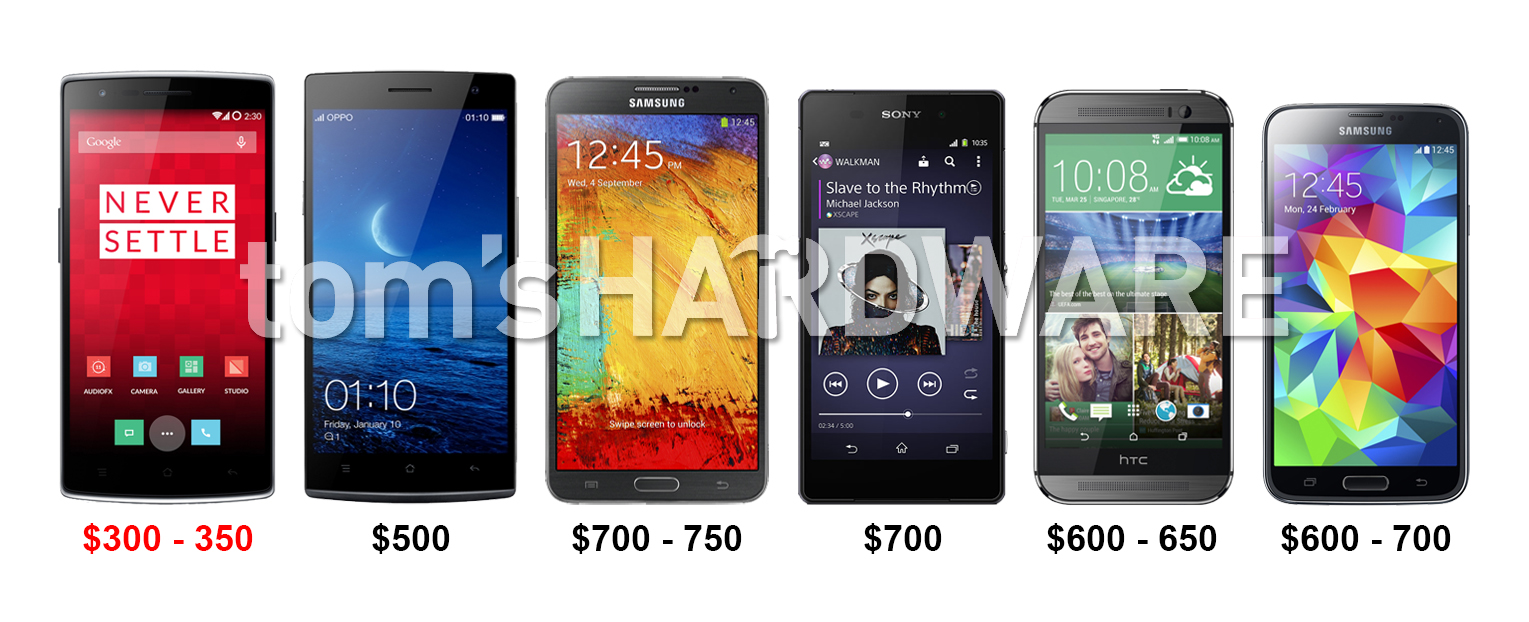
| Header Cell - Column 0 | OnePlusOne | OppoFind 7a | SamsungGalaxy Note 3 | SonyXperia Z2 | HTC One M8 | SamsungGalaxy S5 |
|---|---|---|---|---|---|---|
| Outright | $300 - $350 | $500 | $700 - $750 | $700 | $600 - $650 | $600 - $700 |
| Contract | N/A | N/A | $300 - $350 | $180 CDN | $200 - $230 | $200 - $250 |
All things considered, when you get down to brass tacks, it is all about the price, and the OnePlus One is selling for an unbelievably low price given its specifications. When compared to the outright price of comparable phones from other top OEMs, it's half the price. Even when compared to its cousin, the Oppo Find 7a, the One comes out on top, costing $200 less. However, the question that remains is how is OnePlus achieving this since when you look at the One's specs, and guestimate the BOM, it must be selling for almost no profit.
In answer to this, OnePlus has now released more information about the availability of the One, making it a little clearer how they are achieving such a low price. The 16 GB One in international markets will ONLY be available in very limited quantities in mid-May to the 100 participants of the Phone Smash contest, and late-May to the 300 friends they can invite. The 64 GB model will start being available in early-June, but again only in limited quantities to those with invites. It will only be in late-June that the One will be generally available.
With this staggered release, which is similar to how other high-end smartphones are sold in China, OnePlus can build up the hype for the One by getting limited quantities into its superfans' hands first. Then it makes it available to regular buyers after a few months when component costs will surely have dropped in price. Unfortunately, that also means that come June it may no longer be as much of a "Flagship Killer" as it is today, since newer devices like the LG G3 and rumored Galaxy S5 Prime will have been announced, or perhaps even released. Of course, neither of these phones will be $300.
It is also important to remember that since One does have some limitations as far as carrier support, especially in the U.S. where it doesn't work on Verizon, that it simply may not be the right phone for you, despite its low price. While we always suggest that you try and buy a phone outright so you don't lock yourself in an unnecessary contract, sometimes you do not have a choice. With the more flexible subsidy model that many North American carriers have introduced as of late, it can be pretty tempting to be able to pick up a top of the range phone for only $200.
While we now know quite a lot about the OnePlus One, and approximately when we'll be able to buy one, there are still a few questions OnePlus needs to answer. There is a lot of confusion as to how the OnePlus invite system works. Without an invite, you will not be initially able to buy the One, and it still hasn't been made clear how you go about getting one (other than from a Phone Smash winner). We'd also like to hear when the Style Swap back covers will be available and how much they'll cost since the rumored $50 seems a tad steep (but we guess if they are not making much of a profit on the phone...). Hopefully, OnePlus will be able to answer some of those questions soon, so check back with Tom's for the latest OnePlus news.
UPDATE:
Due to popular demand, we’ve decided to include another chart comparing the One to the Nexus 5, since from a price perspective, it is the One’s closest competitor.
| Header Cell - Column 0 | OnePlus One | Google Nexus 5 |
|---|---|---|
| Screen Size | 5.5-inch | 4.95-inch |
| Dimensions | 152.9 x 75.9 x 8.9 mm6.02” x 2.99” x 0.35” | 137.84 x 69.17 x 8.59 mm5.43” x 2.72” x 0.34” |
| Weight | 162 g5.71 oz. | 130 g4.59 oz. |
| Rear Camera | 13 MP, f/2.0, 28 mm,Dual-LED flash | 8 MP, f/2.4, 30.4 mm, OIS,Single-LED flash |
| Front Camera | 5 MP | 1.3 MP |
| SoC | 2.45 GHz Snapdragon 801(MSM8974AC) | 2.26 GHz Snapdragon 800(MSM8974AA) |
| RAM | 3 GB | 2 GB |
| Storage | 16/64 GB | 16/32 GB |
| Screen Type | IPS LCD | IPS LCD |
| Resolution/PPI | 1080 x 1920/401 ppi | 1080 x 1920/445 ppi |
| Battery | 3,100 mAh | 2,300 mAh |
| Speakers | Stereo (bottom-facing) | Mono |
| LTE Int’l Bands | 1/3/4/7/17/38/40 | 1/3/5/7/8/20 |
| LTE NA Bands | N/A | 1/2/4/5/17/19/25/26/41 |
| OS | CyanogenMod 11S(Android 4.4) | Stock Android 4.4 |
| Price | $300 - 350 | $350 - 400 |
Also, OnePlus just revised their release schedule due to demand for the 64 GB model. Instead of making 16 GB White units available to the first batch of 300 invites, OnePlus will now have in “Late May to early June - Larger batch 64GB Sandstone Black” instead. General availability of the One in late-June has not changed.
Follow Alex Davies @AlexBDavies. Follow us @tomshardware, on Facebook and onGoogle+.
-
scook9 ReplyI would have loved to see the Nexus 5 in the comparative.
This times 10....seems like a huge hole in this article -
alex davies My intent was to compare the OPO to 2014 flagships, since this is what OnePlus is saying it "kills." Admittedly, the Note 3 is from 2013, but it is here more to show how the One compares to it in size.Reply
If I had included the Nexus 5, the One would have blown it away in basically all departments, apart from physical size and price. -
apertotes Reply13241811 said:If I had included the Nexus 5, the One would have blown it away in basically all departments, apart from physical size and price.
And that is a very useful comparison for somebody with 300 dollars to spend on a smartphone.
-
Chris Droste LG G2, HAS OIS, and directly competes with all of these in features and specs, runs 4.4.2, 5.2" IPS 1080p display 800 SoC 2.26GHZ 2GB Ram 32GB storage..but we won't mention any of that oh no, because it was released more than all of 6 months ago...Reply -
alex davies Reply13241811 said:If I had included the Nexus 5, the One would have blown it away in basically all departments, apart from physical size and price.
And that is a very useful comparison for somebody with 300 dollars to spend on a smartphone.
A new chart comparing the One to the Nexus 5 has been added. Thanks for the feedback.
-
apertotes Reply13242993 said:13241811 said:If I had included the Nexus 5, the One would have blown it away in basically all departments, apart from physical size and price.
And that is a very useful comparison for somebody with 300 dollars to spend on a smartphone.
A new chart comparing the One to the Nexus 5 has been added. Thanks for the feedback.
Wow! A+ service from Tom's Hardware. Thanks a lot!